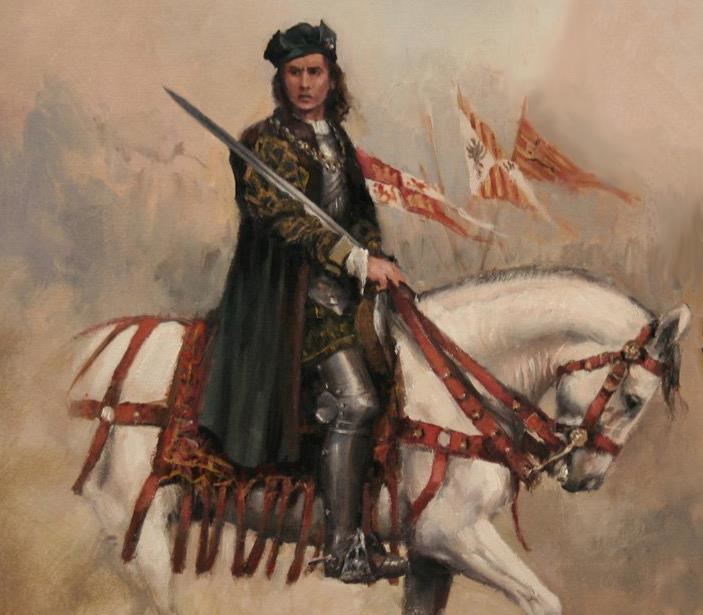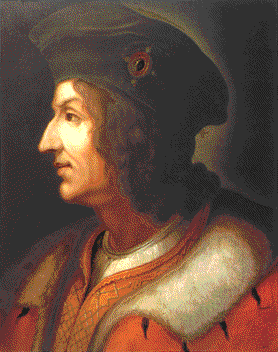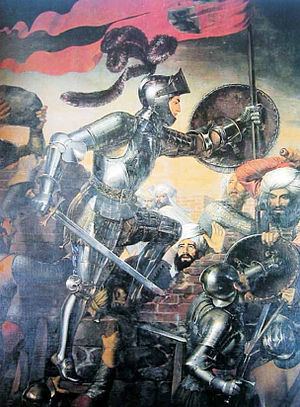Allegiance Spain Years of service 1482–1504 | Rank General Name Gonzalo de | |
 | ||
Nickname(s) El Gran Capitan ("The Great Captain") Battles/wars Granada War 1st Italian WarAtella (1496)3rd Turkish-Venetian WarKefalonia (1500)2nd Italian WarCerignola (1503)Garigliano (1503) Other work Viceroy of Naples (1504–1507) Role Duke of Terranova and Santangelo Died December 2, 1515, Cordoba, Spain Children Elvira Fernandez de Cordoba y Manrique Parents Pedro Fernandez de Cordoba, Elvira de Herrera Similar People Ferdinand II of Aragon, Isabella I of Castile, Pedro Navarro - Count of, Prospero Colonna, Bartolomeo d\'Alviano | ||
Paz paz paz gonzalo fernandez de cordoba
Gonzalo Fernández de Córdoba, or simply Gonzalo de Córdoba (1 September 1453 – 2 December 1515), Duke of Terranova and Santangelo, Andria, Montalto and Sessa, was a Spanish general who fought in the Conquest of Granada and the Italian Wars. He reorganized the emerging Spanish army and its tactics, and was regarded as the "father of trench warfare". He was also called "The Great Captain" (Spanish: El gran capitán). Many influential men fought under him (including Francisco Pizarro's father), and he was admired by the generation of conquistadors which followed.
Contents
- Paz paz paz gonzalo fernandez de cordoba
- Gran capitan gonzalo fernandez de cordoba
- Early life
- Marriage
- Reconquista
- Italian campaigns
- First Italian War
- Second Italian War
- Later life
- Legacy
- References

Gran capitan gonzalo fernandez de cordoba
Early life

De Córdoba was born at Montilla in what is now the province of Córdoba, the son of Pedro Fernández de Córdoba (Count of Aguilar) and his wife Elvira de Herrera. He and his older brother, Alonso, were orphaned when they were young. As the younger brother in a society practicing primogeniture, Gonzalo could not expect much in the way of inherited wealth or titles, and of his two options – the church or the military – he chose the latter. He was first attached to the household of Alfonso, Prince of Asturias, the half-brother of King Henry IV of Castile. After Alfonso's death in 1468 Córdoba devoted himself to Alfonso's sister, Isabella of Castile.

When King Henry IV died in 1474 Isabella proclaimed herself successor queen, disputing the right of Juana la Beltraneja (the king's 13-year-old daughter and her niece) to ascend the throne. During the ensuing civil war between the followers of Isabella and Juana, there was also conflict with Portugal since King Alfonso V of Portugal sided with his niece Juana. Córdoba fought for Isabella under Alonso de Cárdenas, grand master of the Order of Santiago. After the battle of Albuera, Cárdenas praised him for his service.
Marriage

Widowed at age 36, de Córdoba married Luisa Manrique de Lara (a lady-in-waiting to Queen Isabella I of Castile) on 14 February 1489. His only surviving daughter, Elvira Fernández de Córdoba y Manrique, would inherit all their titles upon his death in 1515. To keep her father's name, she married within her family.
Reconquista

During the ten-year-long conquest of Granada under the Catholic monarchs, de Córdoba completed his apprenticeship under his brother Alonso, grand master of Santiago Alonso de Cárdenas, and the counts of Aguilar and of Tendilla (who he called his masters). It was a war of sieges, defending castles and towns, of skirmishes and ambushes in mountain defiles. The skills of a military engineer and a guerilla fighter were equally useful. Córdoba's most distinguished feat was the defence of the advance post of Íllora. Able to speak Berber (the language of the emirate), he was chosen as one of the officers to arrange the surrender; with the peace of 1492 he was rewarded with land in the town of Loja, near Granada.
Italian campaigns
De Córdoba was an important military commander during the Italian Wars, holding command twice and earning the name "The Great Captain".
First Italian War
The Italian Wars began when Charles VIII of France marched into Italy with 25,000 men to make good an Angevin dynastic claim to the Neapolitan throne. When the Catholic monarchs supported King Ferrandino against Charles VIII of France in 1495, de Córdoba (then in his mid-forties) was chosen by the Queen to command the Spanish force of a little more than five thousand men.

Ordered to pit his light infantry and cavalry against heavy French forces, his first major battle in Italy (the 1495 Battle of Seminara) ended in defeat at the hands of Bernard Stewart d'Aubigny. The following year, de Córdoba captured the rebel county of Alvito for the king; avoiding a pitched battle, he used his mobile forces to drive the French back to Calabria.
During de Córdoba's first command he was primarily in Calabrian mountain warfare, which resembled his former experience in Granada. There was, however, a material difference in the enemy. The French forces under d'Aubigny consisted largely of Swiss mercenary pikemen, and their own men-at-arms, the heavily-armoured professional cavalry gendarmes. With his veterans of the Granadine war (foot soldiers armed with sword and buckler—or arquebuses and crossbows—and light cavalry), with endurance unparalleled among soldiers of the time, he could conduct guerrilla warfare which wore down his opponents.
His experience at Seminara taught him that more was required on the battlefield. The battle was lost primarily because Ferdinand, ignoring de Córdoba's advice, persisted in fighting a pitched battle with their more lightly-equipped troops. In the open field, the loose formation and short swords of the Spanish infantry put them at a disadvantage against a charge of heavy cavalry and pikemen. De Córdoba introduced a closer formation, dividing the Spanish infantry among the central body of pikemen and shooting wings. Known as a colunella, it was the original pike and shot formation. The French were expelled by 1498 without another battle, and he returned home.
Second Italian War
When de Córdoba returned to Italy, he and condottieri such as Pedro Navarro had to drive out the Turks from Kefalonia. Helping the Venetian navy reconquer the Castle of Saint George on 25 December 1500, they killed over 300 people (including the Albanian leader of the Gisdar garrison) in the campaign against Frederick IV of Naples.
Córdoba was again on Italian soil in 1501. Ferdinand II of Aragón had entered into a compact with Louis XII of France to divide the kingdom of Naples. Córdoba was chosen to command the Spanish portion of the coalition.
After Frederick IV of Naples abdicated, the French and Spanish fought a guerilla war while negotiating the partition of the kingdom. De Córdoba had an outnumbered army, besieged in Barletta by the French. The war was divided into two similar phases. In late 1502 and early 1503 the Spaniards were besieged in Barletta, near the Ofanto on the Adriatic. De Córdoba refused to be tempted into battle by French taunts or his soldiers' discontent. He used Aragonese partisans and his men to disrupt French communications, diverting his men with a tournament between Italian knights (under Ettore Fieramosca) and French prisoners.
When de Córdoba was reinforced, and the French spread out their forces to forage for supplies, he pounced on their supply depot in the Battle of Cerignola. He took up a strong defensive position (outnumbered three-to-one) and hastily erected field works strengthened with wires. The French unsuccessfully attacked from the front, were assailed in the flank and routed in a half-hour by a combination of firepower and defensive measures. Later operations on the Garigliano against Ludovico II of Saluzzo were similar, leading to a French retreat from the Kingdom of Naples.
Later life
Córdoba was appointed Viceroy of Naples in 1504. Jealous of him, Ferdinand II of Aragon accused him of profligately spending the public treasury to reward his captains and soldiers; the 1504 death of Queen Isabel I of Castile deprived him of a protector, and he was recalled in 1507. Although Ferdinand praised Córdoba, he gave him nothing else to do until his death. Gonzalo Fernández de Córdoba died on 2 December 1515 at his villa near Granada from malaria at age 62.
Legacy
Córdoba was a pioneer of modern warfare. As a field commander, like Napoleon three centuries later, his goal was the destruction of the enemy army. Córdoba systematically pursued defeated armies after a victory to minimize future resistance. He helped found the first modern standing army (the nearly-invincible Spanish infantry which dominated European battlefields for most of the 16th and 17th centuries). The best generals of Charles V, Holy Roman Emperor and Philip II of Spain were Córdoba's pupils or were trained by them.
His influence on military tactics was profound. Wellington's Torres Vedras campaign resembled Córdoba's campaign at Barletta and the Battle of Assaye is comparable to his campaign at Garigliano. Córdoba directed the first battle in history won by gunpowder small arms (the Battle of Cerignola). At the end of the battle, he issued a call to prayer (toque de oracion, adopted later for all Western armies); when Córdoba saw the fields full of French bodies, he ordered the playing of three long tones and prayers for the fallen.
He left no sons, and was succeeded in his dukedoms by daughter Elvira Fernández de Córdoba y Manrique. Córdoba's burial place, the Monastery of San Jerónimo in Granada, was built in Renaissance style by his wife and daughter. It was desecrated by Napoleonic troops under the Corsican General Sebastiani at the beginning of the 19th century. Stone from the tower was used to build the Puente Verde bridge over the Genil. The monastery was fully restored at the end of the 19th century.
Córdoba's extensive knowledge was passed on to the next generation through the men who served under him. Several, such as his steward Amador de Lares, accompanied Hernán Cortés on his conquest of the Aztec Empire.
